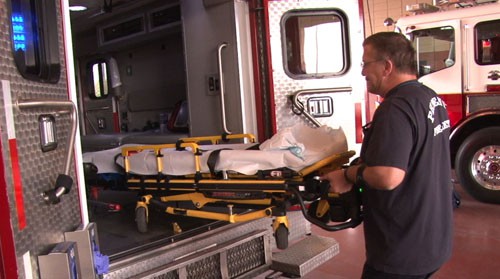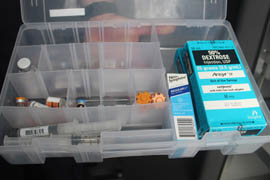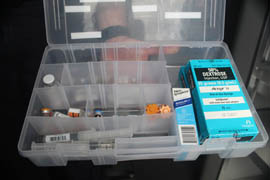Cronkite News has moved to a new home at cronkitenews.azpbs.org. Use this site to search archives from 2011 to May 2015. You can search the new site for current stories.
To check heat, ambulances add climate-controlled drug boxes
PHOENIX – A small solar-powered compartment located behind the passenger’s seat of some of Southwest Ambulance’s vehicles keeps stores of potentially life-saving drugs at 70 to 74 degrees.
Since temperatures inside ambulances can reach up to 130 degrees or more during summer, climate-controlled drug storage can make a big difference, according to Billy Warren, operations manager for Southwest Ambulance.
“When we’re on call, last thing we need is for a medication not to work,” Warren said.
Though the effect that heat can have is still under debate, the Federal Drug Administration recommends that most drugs be stored below 86 degrees.
Southwest Ambulance, the largest private provider in the state, purchased 40 new vehicles last year for its fleet serving the East Valley that have the solar-powered boxes for drugs. Warren estimated the cost of the upgrades at $2,000 a vehicle.
“This is the wave of the future,” he said.
Will Humble, director of the Arizona Department of Health Services, has been encouraging ambulance operators to install the boxes for years.
Though he said there have long been differences between the “free-flowing” culture of emergency medical services and the more controlled environments of pharmacies and hospitals, the gap may be closing.
When the state revised its regulations of ambulances in 2007, Humble said he proposed a requirement that ambulances be equipped with temperature-controlled boxes. Due to unanimous opposition from stakeholders and the Emergency Medical Services Council, an advisory board, the provision wasn’t adopted, he said.
Humble acknowledged the lack of scientific research about the effects of heat on drug potency but said requiring ambulances to use climate-controlled boxes would be a common-sense measure to protect public health. The boxes, he said, would take the pressure off paramedics to remember to swap out drug boxes and ice packs, which many ambulance providers use.
“One of the things I’ve found pretty consistently is if you have to rely on people to do the right thing every time it’s going to be a lot less effective,” he said.
The United States Pharmacopeial Convention, a scientific nonprofit organization that sets standards enforceable by the Food and Drug Administration, offers recommendations for drug storage on emergency medical vehicles. They include taking measures to maintain drugs “within the allowable limits of the labeled storage requirements” but don’t mention temperature-controlled boxes.
Dr. John Gallagher, emergency medical services medical director for Phoenix Fire Department, which operates ambulances, said he doesn’t think the boxes should be required for now.
“If they’re going to make that type of change then there needs to to be good reason,” he said.
Gallagher said some drugs such as rapid-sequence intubation drugs and Cardizem, a cardiac drug, do need to be stored in refrigerated boxes. Others need to be discarded if not used after a certain number of weeks.
But as medical director Gallagher said he chooses not to include those drugs in the Phoenix Fire Department drug boxes, eliminating the need for temperature-controlled boxes.
“They’re expensive,” he said. “So to me, they should be used only when it’s appropriate.”
He also said requiring ambulances to store drugs in temperature-controlled boxes wouldn’t make sense because they aren’t kept in temperature-controlled spaces when shipped by train or truck.
Mark Bosen, a medication management specialist at the University of Arizona College of Pharmacy, said some exposure to extreme temperatures doesn’t always affect medications, even though the FDA recommends many should stored between 55 and 86 degrees.
“Can the medications be less effective? Absolutely,” he said.
But Bosen said research on drugs and temperature extremes shows drugs lose potency at insignificant levels. Since paramedics administer drugs based on a case-by-case basis based on patient response, a medic could easily adjust for a loss of 10 percent potency.
“The dosing isn’t as precise as you might think,” he said.












